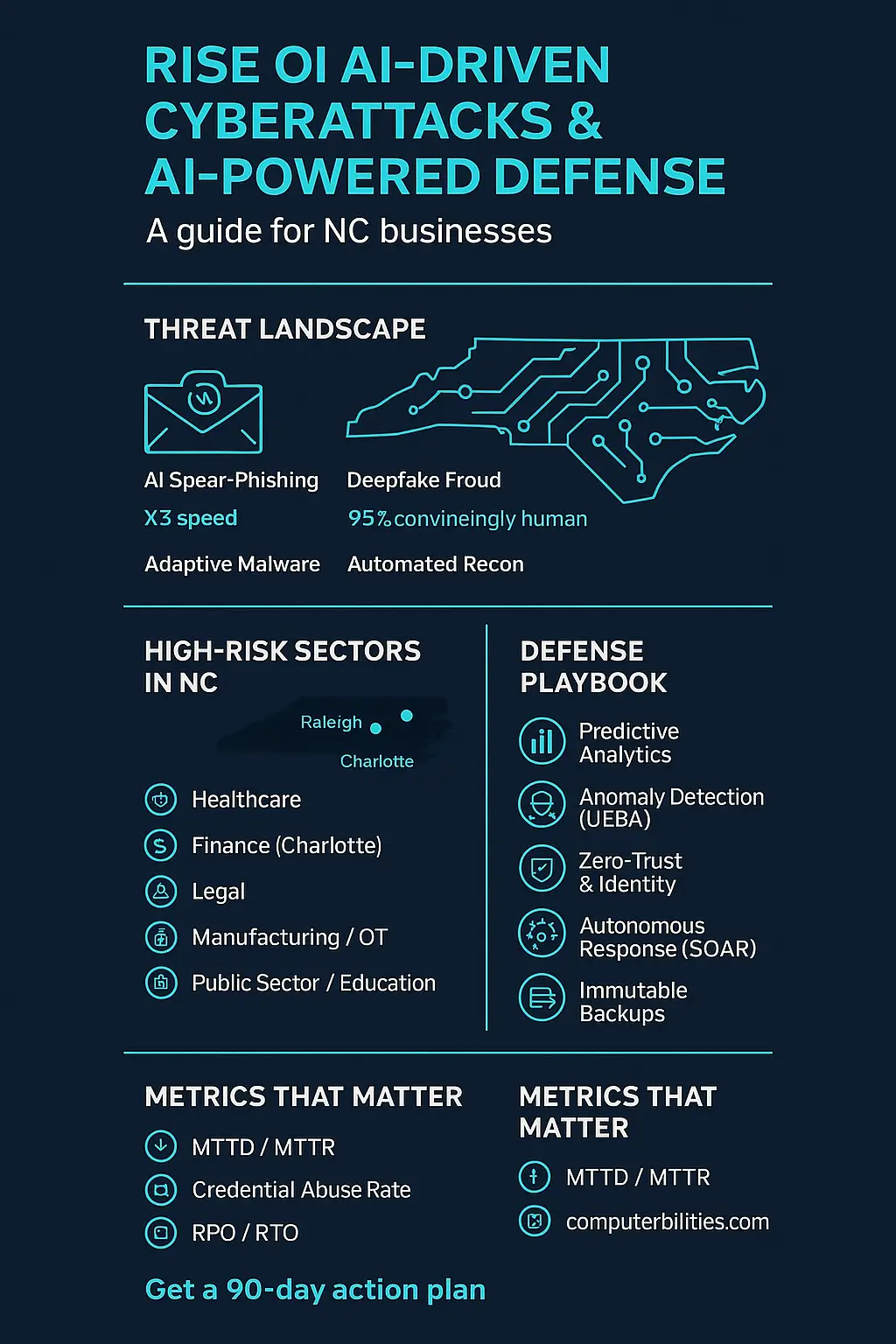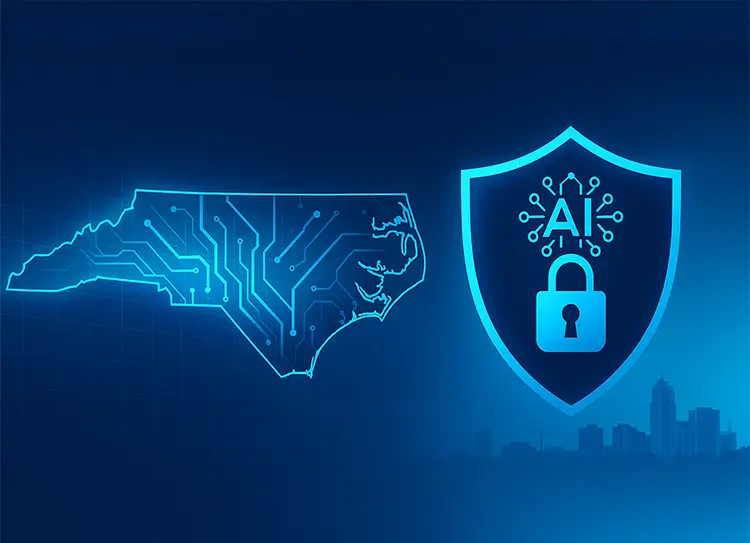Rise of AI-Driven Cyberattacks & AI-Powered Defense: What North Carolina Organizations Must Do Now
Artificial intelligence is reshaping both sides of the cyber battlefield. Adversaries are using AI to scale phishing, automate reconnaissance and exploitation, and craft deepfakes that fool even seasoned staff. At the same time, defenders are deploying AI-powered detection, response, and hardening to close the gap. For organizations across North Carolina—healthcare systems in the Triangle, legal and financial firms in Charlotte, manufacturers across the Piedmont, and public entities statewide—the question is no longer if AI will impact your cyber risk posture, but how quickly you can operationalize AI-powered defense within your IT Support and managed IT services program.
This article explains how AI-driven cyberattacks work, what “AI-powered defense” actually delivers, and a practical roadmap for North Carolina businesses to adopt these capabilities through IT Services and Managed IT Services—without overextending budgets or teams. It also draws on current reporting that shows the trend line is accelerating: experts warn of an oncoming era of “zero-day AI” attacks; studies suggest the majority of ransomware operations now leverage AI; and security leaders across government and industry stress that only AI can match AI at machine speed.

What We Mean by “AI-Driven Cyberattacks”
1) Automation at Scale
AI allows attackers to automate what used to be painstaking manual work—credential stuffing, vulnerability scanning, and exploit selection—compressing weeks of effort into minutes. Emerging research and industry reporting indicate that cybercriminals are already using AI to generate malware variants, bypass CAPTCHAs, and supercharge phishing. One recent analysis attributed AI to powering a large majority of ransomware activity, a figure projected to rise.
North Carolina lens: For multi-site providers (think statewide healthcare groups or regional retailers headquartered in Raleigh), this speed means your attack surface is probed constantly, not episodically. If your patching cadence and anomaly detection remain human-paced, you’ll always be late.
2) Personalization and Persuasion
Generative AI can craft emails and messages that mirror an executive’s tone, reference timely projects, or mention local details (e.g., “Duke campus visit Friday”)—creating highly convincing spear-phishing. Investigations show nation-state groups have used frontier models to generate fake IDs, résumés, and technical content that smooth the path into target organizations.
NC example: A Charlotte finance team receives a “CFO” voice note (a deepfake) asking for a same-day wire to a familiar vendor. The message references a real acquisition target in Research Triangle Park, scraped from public filings. The voice sounds right. The context feels right. The transfer proceeds.
3) Adaptive Evasion
Machine-learning-assisted malware can probe endpoint defenses, observe responses, and morph to avoid signatures—turning legacy AV and static rules into speed bumps. Multiple vendors and analysts now describe this as the central challenge of 2025: legacy controls alone can’t keep up with AI-accelerated offense.
What “AI-Powered Defense” Really Delivers
AI-powered defense is not a single product; it’s an operating model that embeds machine learning across your prevention, detection, and response stack. The leading approaches share four properties:
- Predictive analytics over “rear-view” alerts.
Systems learn normal baselines across identities, data flows, and applications, then anticipate drift and risk before an IOC fires. Vendors advocating predictive, real-time analytics argue this is the only sustainable counter to AI-accelerated threats. - Anomaly-first detection and correlation.
Rather than wait for a known signature, AI correlates weak signals—an unusual login pattern here, an off-hours data pull there—into a high-fidelity incident graph. Industry coverage highlights AI-driven anomaly detection as a top defensive use case tied to measurable savings. - Autonomous containment.
When confidence is high, AI-assisted SOAR isolates an endpoint, suspends a token, throttles an API key, or geo-fences network segments without waiting on a human. Defense leaders across government have emphasized that meeting AI-powered attacks requires comparable automation on the blue-team side. - Continuous model hygiene.
As models become part of your SOC, you must monitor them for data drift, poisoning attempts, and prompt injection. Service-provider–focused guidance stresses model validation and cross-organizational information sharing as core program disciplines.
Bottom line for NC organizations: AI-powered defense shrinks mean time to detect (MTTD) and mean time to respond (MTTR) from hours to seconds—critical for hospitals, public services, and manufacturers where downtime has real-world consequences.
The North Carolina Risk Landscape
1) Healthcare and Life Sciences (Raleigh–Durham, Winston-Salem)
Protected health information (PHI) fetches a premium and ransomware actors know healthcare has low tolerance for downtime. AI-assisted spear-phishing and initial access brokerage make it easier to foothold into hospital networks. AI-powered defense—UEBA across clinicians and devices, micro-segmentation, and immutable backups—should be mandatory priorities.
2) Financial Services (Charlotte)
As a national banking hub, Charlotte institutions are prime targets for fraud and data theft. Expect deepfake voice fraud against treasury operations, model-assisted mule account creation, and AI-generated synthetic identities. Adopt step-up verification for high-risk actions and expand anomaly detection around payments and SWIFT interactions.
3) Legal & Professional Services (Triangle, Triad)
Firms hold sensitive deal folders and litigation strategy. A single AI-engineered BEC (business email compromise) can trigger a breach notification cascade. Emphasize identity protection, DMARC enforcement, just-in-time access, and continuous monitoring of exfiltration paths (M365, DMS, and eDiscovery tools).
4) Advanced Manufacturing & Utilities (Piedmont, statewide)
Operational technology (OT) is increasingly networked, and adversaries now blend IT and OT tactics. Recent market moves—like major industrial cybersecurity investments—signal rapid maturation in this segment; service providers are aligning their stacks accordingly.
5) Public Sector and Education (statewide)
Municipal services, K-12, and higher education remain ransomware magnets. AI supercharges targeting and lateral movement. Standardize on zero-trust network access (ZTNA), privileged access management (PAM), and pre-negotiated incident response (IR) runbooks with your Managed IT Services partner.
A Practical, Budget-Aligned Roadmap for AI-Powered Defense
Step 1: Establish the data foundation (0–60 days).
Inventory identities, endpoints, SaaS apps, and data repositories. You cannot defend what you can’t see; even the best AI requires a clean substrate. Analysts covering RSAC 2025 make this point explicit: AI security fails when the estate is unknown or uncontrolled.
Step 2: Prioritize anomaly detection and identity security (0–90 days).
Roll out AI-augmented EDR/XDR with behavioral analytics. Pair with phishing-resistant MFA (FIDO2/WebAuthn) and risk-based access policies. Start with your “crown jewels”: EMR/EHR systems, finance/ERP, legal DMS, and OT gateways.
Step 3: Automate the first 10 response actions (0–120 days).
Codify playbooks for high-confidence triggers: isolate host, reset tokens, disable forwarding rules, revoke OAuth grants, rate-limit or geofence APIs, snapshot VMs, quarantine attachments, and rotate secrets. Even a modest SOAR playbook set yields outsized gains against AI-accelerated attackers.
Step 4: Harden the human layer with AI (ongoing).
Move from annual training to continuous simulation. Use platforms that generate adaptive phishing lures mirroring your own comms style—because that’s exactly what attackers do. Track risk reduction at the team level.
Step 5: Modernize backup, recovery, and business continuity (ongoing).
Air-gapped, immutable backups; frequent recovery drills; and application-level failover. Assume an attacker’s model has already mapped your environment.
Step 6: Formalize governance and model hygiene (quarterly).
Create a cross-functional AI risk committee (IT, security, legal, compliance, operations). Validate detection models, review drift, and monitor for poisoning. Share sanitized IOCs and TTPs with peer groups and ISACs.
Where Managed IT Services and IT Support Fit
For many small and midsized organizations in North Carolina, building this program in-house is impractical. Managed IT Services (MSPs) and co-managed IT models can deliver AI-powered defense as a service:
- 24×7 monitoring with AI-assisted triage and escalation—measured SLAs, not best-effort.
- Co-managed SOC that integrates with your existing tools and adds managed detections for M365/Google Workspace, popular EDRs, and critical SaaS apps.
- Proactive hygiene: patch orchestration, vulnerability scanning with AI-prioritized remediation, configuration drift monitoring, and least-privilege enforcement.
- Executive reporting that turns security into business language—risk reduced, time saved, dollars protected.
Industry reporting underscores the macro trend: defense leaders argue you must “fight AI with AI,” and operational savings from AI/automation in security are already measurable.
Case-Style Scenarios (Drawn from Common Incidents)
- Raleigh healthcare group—ransomware pre-empted.
AI-driven anomaly detection flags an outpatient clinic workstation attempting lateral movement at 2:11 a.m. SOAR auto-isolates the endpoint, revokes a compromised OAuth token, and blocks a malicious PowerShell sequence. Clinic opens on schedule. CFO sees the report at 8 a.m.: incident contained in 32 seconds; zero patient impact. - Charlotte asset manager—deepfake wire attempt.
Treasury receives a voice message from the “CFO” with same-day wire instructions. A just-in-time policy requires step-up verification for any wire initiated outside business hours. Transaction stalls. Security reviews the audio and confirms AI synthesis markers. Treasury staff complete post-incident training; the lure variants are added to simulation campaigns. - Triad manufacturer—OT gateway targeting.
Attackers probe an outdated VPN concentrator exposed to the internet. AI-based network analytics detect protocol anomalies to the OT gateway and geofence the connection. The legacy VPN is decommissioned within 48 hours; ZTNA replaces it.
Governance, Compliance, and Trust
AI introduces novel risks—model bias, prompt injection, data leakage—and new obligations to boards, customers, and regulators. A defensible program in North Carolina should:
- Document your model lifecycle. How detection models are trained, tested, and monitored; how false positives are handled; when human-in-the-loop is enforced.
- Define data boundaries. What telemetry leaves your environment; how it’s anonymized; where it’s processed and stored.
- Prove resilience. Tabletop exercises, red-team simulations (including AI-assisted scenarios), and audited restore drills.
Leading commentary in 2025 stresses that AI isn’t a silver bullet; fundamentals still matter. AI is a force multiplier for both sides—your outcomes depend on disciplined implementation.
Tooling Blueprint (Vendor-Neutral)
- Identity & Access: phishing-resistant MFA, conditional access, continuous session risk scoring.
- Endpoints: EDR/XDR with ML-powered detections; device control and memory protection.
- Email & Collaboration: AI-aided phishing detection, anomaly-based forwarding rule alerts, brand spoofing controls (SPF/DKIM/DMARC).
- Network & Cloud: NDR with behavior analytics, micro-segmentation, cloud posture management with AI-prioritized misconfigurations.
- Data Security: content classification, exfiltration analytics (blocking unusual destinations, throttling), and just-in-time access.
- SOAR: playbooks for containment, ticketing, comms, and evidence capture.
Market coverage highlights that industrial and service-provider security stacks are adding “predictive and real-time” analytics layers—an indicator of where budgets are shifting.
Metrics That Matter (Business-Level KPIs)
- MTTD / MTTR at P95: track the tail, not just averages.
- Credential Abuse Rate: compromised OAuth grants, token replay, impossible travel.
- High-Risk Change Lead Time: how fast you can patch or reconfigure after detection.
- Recovery Point/Time Objectives (RPO/RTO): for the top five business services.
- Training Risk Index: click-through and report-rate for adaptive simulations.
- Board-Level Risk Reduction: scenarios prevented, dollars preserved (convert downtime avoided and fraud blocks into financial terms).
The Road Ahead
Analysts and security leaders warn of a looming phase where autonomous AI agents can chain reconnaissance, initial access, lateral movement, and exfiltration with minimal human oversight—the “zero-day AI attack” era. Simultaneously, coverage shows AI has already tipped the scales in ransomware’s favor, and that forward-leaning defenders are moving to predictive analytics, autonomous response, and AI-assisted hygiene to keep parity. The message is consistent: your only sustainable defense against AI-accelerated offense is AI-accelerated defense.
Conclusion: A North Carolina Call to Action
From Charlotte’s finance corridor to the Research Triangle’s hospitals, biotech, and universities, the state’s prosperity rides on digital trust. AI-driven cyberattacks threaten that trust not with one big headline, but with a steady drumbeat of near-misses, fraudulent transactions caught late, and quiet data leaks that surface months later.
You do not need a moonshot to get ahead. You need a realistic program, delivered at pace:
- Establish visibility and control.
- Deploy anomaly-first detection with AI.
- Automate the first ten response actions.
- Train continuously—using AI to fight AI.
- Rehearse recovery until it’s boring.
How Computerbilities can help: As a North Carolina-based IT Services and Managed IT Services partner, we integrate AI-powered defense into pragmatic IT Support plans—24×7 monitoring, co-managed SOC, automated hygiene, executive reporting, and IR readiness. If you’d like a no-obligation assessment tailored to your sector (healthcare, finance, legal, manufacturing, public sector), we’ll map gaps and produce a 90-day action plan you can execute—whether with us or your existing team.

